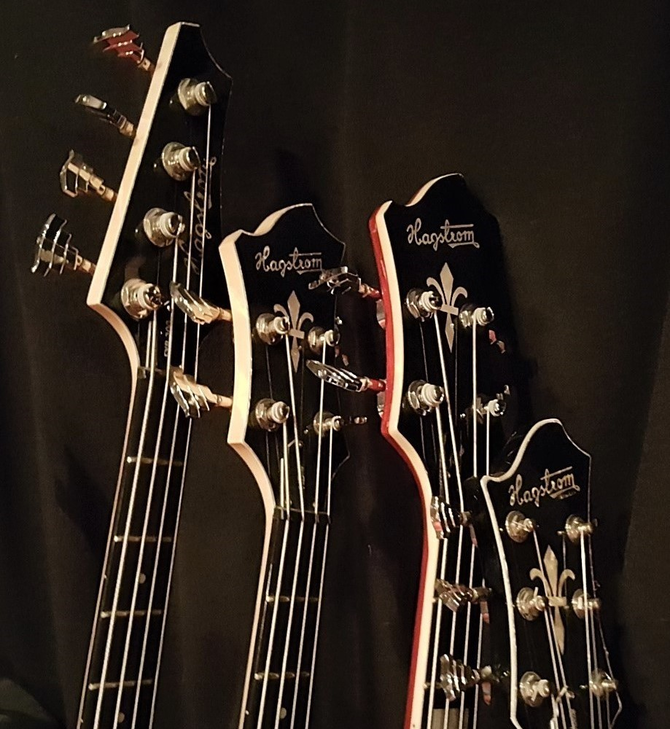Over the years, I’ve bought instruments and amps that work well on stage. It’s important that things feel good and are easy to handle on stage. Since I’m in the studio a lot right now, I’ve changed my gear a bit but all in all, things are the same.
Bass:

Yeah, guess I’ve gotta admit it. I’m really into Hagström’s basses. Hagström has resurfaced in the US and, though the basses are made in China, they are really doing well on the market again. The new owners bought all the machines and tools so you’re getting the same gear and pick-ups, but the brand is still owned by the Swedish Hagström family who approve all manufactured products, so the end result is great. Really great! You get awesome high-quality instruments and gear, at a surprisingly low cost.
I prefer playing on one of my Hagström HB 4’s. Unbelievably useful basses with a warm round and soft bass sound. Unfortunatyely they are out of production but with some TLC my three HB 4’s will outlive me. If I need a long sustain or sharper attack, I go to my Hagström Swede bass. If I wanna go for a detuned bass, I grab my long-necked Hagström FXB 200.
Both my bass and guitar run through the fantastic EBS Reidmar, which has a balanced XLR output that goes directly into my sound card. The EBS Reidmar is just a little piece of equipment with a large sound. Reidmar was the king of the Dwarfs in Norse mythology, so the name really fits. I like it because it doesn’t change your audio, just amplifies it like it should. It’s easy to hear the bass’ own sound right though the amp. I use it on stage too, with two EBS classic 1 x 12 cabinets. I promise you, that little rig can make even large rib cages vibrate! You´ll feel it in your gut, where the bass should be felt.
Guitar:
When playing live i used to do it on the Yamaha APX 700 II. But it had a little weak tone, or thin tone, for live performances. So I went looking. And Hagström, of course, had just released a new model. The Hagström super Viking. It's a semi hollow so the sound can be "acoustic" but it's thicker...mouchier. And it has a much more varied tone range so I can do all my guitar work on the super viking now. It has the 25.5 inch (648mm) scale length so string tension especially with heavy strings comes close to the acoustics. I'v played the acoustics so long that my grip is firm. But my grip and style works fine on the super viking/hevay strings set up. Also the neck profile is very much like the Yamaha acoustics so I feel right at home. The super Viking is my new axe. I liked it so much I have several of them now. If I need an pure electric guitar, there’s only one left: my Hagström Ultra Swede. It has survived a couple of Fenders, an Ibanez and a way too expensive ESP. The Ultra Swede can handle anything, except possibly the serious hard rock bassy growl. But that’s not really my bag anyway.
Keyboard:
I do pretty much directly on a Midi keyboard. A plastic M-Audio Key rig 49 or a surprisingly "real feel" M-Audio Oxygene 49 MIDI controller. Sometimes I take out my little Yamaha Reface DX. It looks like a toy but the internal tone generator in this puppy is no joke. The way it modifies sound is completely different than any other synth I’ve ever seen but it works great. When I need more traditional piano or organ sounds, I do it on an old Yamaha stage piano, the P115.
I do pretty much directly on a Midi keyboard. A plastic M-Audio Key rig 49 or a surprisingly "real feel" M-Audio Oxygene 49 MIDI controller. Sometimes I take out my little Yamaha Reface DX. It looks like a toy but the internal tone generator in this puppy is no joke. The way it modifies sound is completely different than any other synth I’ve ever seen but it works great. When I need more traditional piano or organ sounds, I do it on an old Yamaha stage piano, the P115.
Drums:
Since I’m no drummer, I use programmed percussion from within the audio production software. Works pretty well for demos. And sometimes after a lot of work, in a production. But Öjje Forsberg, drummer of live band Gus Stop, plays an extensively expanded Roland TD-50 digital drumkit. It's easy to record from and it .... resides in the Gus studio! Handy ehh? So it appears more and more on Gus Muller recordings with Öjje behind them.
Pedals:
When performing live with Gus Stop we often bring a huge amount of pedals to our gigs but during studio recordings, I usually use a clean signal into the computer, allowing me to manipulate the audio later. Occasionally I use my T-Rex Octavius for both bass and guitar since I’ve never found a software octave pedal I liked.
Vocals are usually recorded through a TC-Helicon Voice Tone T1. It has a light compressor, an EQ, but most of all, a good de-esser. Works well. Sometimes when I do all the vocals myself I’ll use my TC-Helicon Voice live 2 in choir mode. It actually sounds like other people so it’s a good emergency fix, though the best thing is of course recording with other human voices.
Microphone:
Up until recently I sang into a Shure Beta 58. It’s a good mic but it’s designed for live performances and studio mics are expensive. I happened to get hold of a mic I’d really wanted for a while for next to nothing, despite it being new. It's a Sennheiser MK8 large membrane mic for studio recordings. The vocals are noticeably more nuanced now…but the mic really picks up everything… I’ll have to go back to my vocal coach…
Recording:
This is a new jungle for me. But I’ve learned to handle it with Steinberg’s CuBase. My producer Micke Moberg also uses CuBase so it’s easy to add things while he’s working on producing the songs. I use the 12 Pro version which has more than I can handle and have al lot of default plug in´s which really make the sound shine. I´v only added the Izotope Ozone 8 for mastering. I use Steinberg’s sound cards, the UR22 mk II and UR44, to make sure the sound input is as good as possible. It’s basically Yamaha stuff, branded as Steinberg.
As you can see I’ve got a soft spot for Hagström, Yamaha and EBS. And live on stage with Gus Stop the pedal board is dressed with three EBS pedals (compressor, Billy Sheehan drive and reverb), two T-rex (Octavius and a booster) and two T-helicon (Vioce tone and a Mic Mechanic 2) . It has been this way for a long time now. I sing, play the bass and guitar on stage so with this set up i feel I can cover all the things I need.
/Gus


